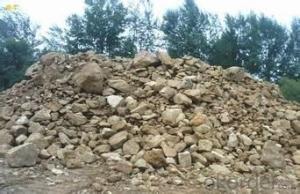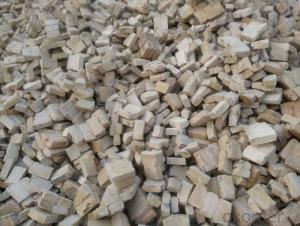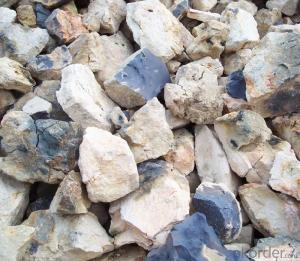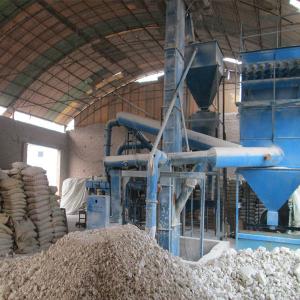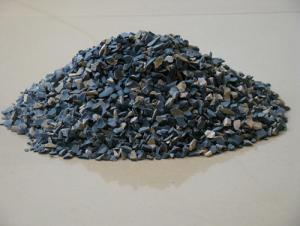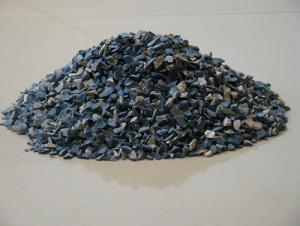Refractory Calcined Rotary Kiln Bauxite of CNBM in China
- Loading Port:
- Tianjin
- Payment Terms:
- TT or LC
- Min Order Qty:
- 11 m.t
- Supply Capability:
- 11111111 m.t/month
OKorder Service Pledge
OKorder Financial Service
You Might Also Like
1.Structure of Calcined Bauxite Description
Bauxite (aluminous soil; Bauxite) is also called the alumina or bauxite, main ingredients are alumina, hydrated alumina containing impurities, is an earthy mineral. White or gray, brown and yellow or light red by iron. From 4 to 3.9 g/cm3 density, hardness, 1 ~ 3 is not transparent, very brittle. Very difficult to melt. Insoluble in water, soluble in sulfuric acid, sodium hydroxide solution. Mainly used for aluminium, refractory material.
2.Main Features of the Calcined Bauxite
Calcined bauxite is one of the principal ore of aluminum. Calcined bauxite contains hydrous aluminum oxides and aluminum
hydroxides, formed through the laterization of aluminous rocks in tropical and subtropical areas .Calcined bauxite is obtained by calcining (heating)superior grade bauxite at high temperature (from 85OC to 1600C) .This removes moisture there.By increasing the alumina content,compared to an alumina content of about 57%to 58% in raw bauxite, calcined bauxite has an alumina content of 84%to88%.The heating is carried out in rotary kilns.
3.Main usage of the Calcined Bauxite
1.aluminium industry
2.precision casting
3 refractory materials
4.aluminum silicate refractory fiber for fiber blanket, refractory brick .
5. refractory cement
Bauxite is an aluminium ore and is the main source of aluminium.
Bauxite is used in cement, chemicals, face makeup, soda cans, dishwashers, siding for houses.
4. Calcined Bauxite Images
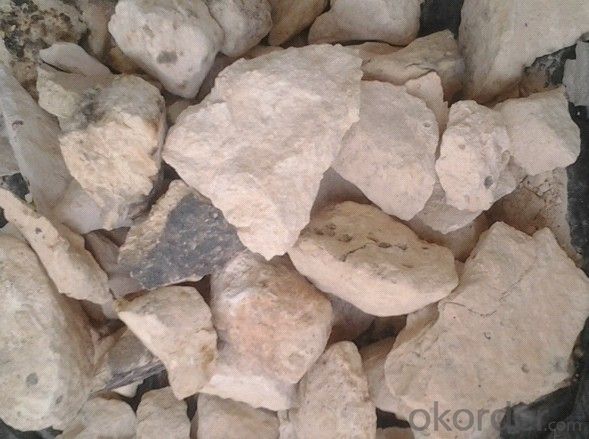
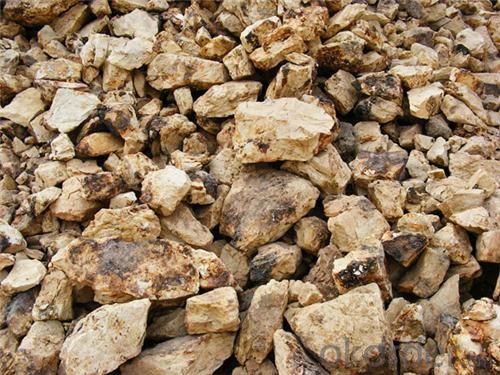
5. Calcined Bauxite Specification
Calcined Bauxite Introduction
Property | Specifications |
Name | aluminous soil ; bauxite |
Color | White, offwhite, auburnish yellow or light red (with Fe) |
Bulk Density | 2.55~3.6 g/cm3 |
Hardness | 1~3 |
Main usages | 1. Aluminium metallurgy 2.Refractory |
Calcined Bauxite Specifications
Classifications | Chemical Component % | Refractoriness | Bulk Demsity | ||
Al2O3 | CaO | Fe2O3 | °C | g/cm3 | |
Superfine | >85 | <0.6 | <1.4 | >1790 | >3.6 |
Level 1 | >80 | <0.6 | <3.0 | >1790 | >3.0 |
Level 2A | 70~80 | <0.8 | <3.0 | >1790 | >2.8 |
Level 2B | 60~70 | <0.8 | <3.0 | >1770 | >2.65 |
Level 3 | 50~60 | <0.8 | <2.5 | >1770 | >2.55 |
6.FAQ of Calcined Bauxite
1). Q: Are you a factory or trading company?
A: We are a factory.
2). Q: Where is your factory located? How can I visit there?
A: Our factory is located in ShanXi, HeNan, China. You are warmly welcomed to visit us!
3). Q: How can I get some samples?
A: Please connect me for samples
4). Q: Can the price be cheaper?
A: Of course, you will be offered a good discount for big amount.
- Q:How long does it take for refractory cement to solidify?
- 1. First you should be aware of the concepts of condensation and condesation time. Refractory cement belongs unshaped refractories, which when added water or liquid binding agent to mix, the agitation material will gradually lose thixotropy or plasticity and become in a state of solidification, thus is solidified. The time needed to finish the process is called solidification time. The whole process is divided into initial and final set. When beginning to lose plasticity called the initial setting, when called plasticity completely lost the final setting. 2. For refractory cement, the solidification time depends on the matching of the material and the parts and using methods. Under normal circumstances, in order to meet the requirements of time of construction, the initial set time should be no shorter than 40min, and the final set time should be no longer than 8H 3. There are also some exceptions. When refractory cement is used for spraying and injection operation together with other refractory castable, the set time is required as short as possible, sometimes flash set is required to prevent the occurrence of peeling or collapse of the spraying layer.
- Q:Procedures for producing common refractory materials?
- The general procedures of producing refractory materials include calcination of raw materials, selection of raw material , crushing, grinding, screening, mixing, ageing mixture, molding, drying, burning and etc. At present, the refractory factory usually purchases the calcined clinker, so the calcination of raw material is no longer a consideration of common refractory plants.
- Q:What are included in roof thermal insulation fireproofing material?
- Aluminium foil, bubble, aluminium foil/air bubbles/fireproofing aluminium foil thermal insulation material, fireproofing bubble thermal insulation material, fire?retardant thermal insulation material, thermal insulation construction materials, aluminum foil insulation material.
- Q:Do you know what the main indicators are for the inspection of refractory materials? Thank you very much for your requests and reports
- Fire resistance, combustion performance, combustion heat value, fire resistance, high temperature resistance, fire rating test and so on. Regular testing institutions are generally reported, Qingdao standard also can, the results are more accurate.
- Q:Which industry does the metallurgy and thermal insulating and refractory material belong to?
- According to "New Economic Industrial Classification", the metallurgy and the thermal insulation refractory matter belong to C category. The manufacturing industry has 30 categories. The non-metallic mineral products industry has 303 classes. The production of building materials of tiles, stones, ect. refers to clay, ceramic tile production, building stone processing, building materials produced by wastes or drogs and subcategories 3035 produced by other building materials. The manufacture of thermal and acoustic insulation materials refers to the manufactuer of mineral insulation materials and other products, like rock wool, mineral?cotton, expanded perlite and expanded vermiculite used for thermal insulation and sound insulation, but it does not include the production of 3039 subcategories, like asbestos thermal insulation and sound insulation materials, and other construction materials.
- Q:What are the fire endurance requirements of class A fire resistant door ?
- Fire endurance of class A fire resistant door is 1.5h. According to the latest fire door requirements, in FMA FMB FMC three forms, A, B and C represent categories, such as FMA on behalf of Class A fire doors (ie thermal insulation fireproof door). Fire endurances of class A,B and C fire doors are 0.5 1.0 1.5 2.0 3.0. Therefore, the fire resistance of fire door needs to be designed and the design paper will make it clear in general.
- Q:what's the fireproof levels of fireproof and thermal inuslation matertial?
- 1, organic materials: B level material is flammable, B1 level material is flame retardant. 2, inorganic materials: Grade A flame-resistant materials are divided into three classes and two kinds of materials.
- Q:Who know about the knowledge of acid refractory material? Please explain in detail.
- Refers to the silicon dioxide
- Q:What are the refractories for converter?
- Magnesia carbon material with large surface repair vessel, in addition to supporting the use of magnesia and magnesia cement.
- Q:How to use fireclay?
- Actually, fire clay is not strong. Fireclay are all clinkers with no strength, also known as "blade mud". It is used as the filler with a thickness of not more than 3mm. Therefore, it can not be used for thermal insulation inside the furnace. Inner thermal insulation of the civil boiler can use "alumina cement", also known as refractory cement.
1. Manufacturer Overview |
|
|---|---|
| Location | |
| Year Established | |
| Annual Output Value | |
| Main Markets | |
| Company Certifications | |
2. Manufacturer Certificates |
|
|---|---|
| a) Certification Name | |
| Range | |
| Reference | |
| Validity Period | |
3. Manufacturer Capability |
|
|---|---|
| a)Trade Capacity | |
| Nearest Port | |
| Export Percentage | |
| No.of Employees in Trade Department | |
| Language Spoken: | |
| b)Factory Information | |
| Factory Size: | |
| No. of Production Lines | |
| Contract Manufacturing | |
| Product Price Range | |
Send your message to us
Refractory Calcined Rotary Kiln Bauxite of CNBM in China
- Loading Port:
- Tianjin
- Payment Terms:
- TT or LC
- Min Order Qty:
- 11 m.t
- Supply Capability:
- 11111111 m.t/month
OKorder Service Pledge
OKorder Financial Service
Similar products
New products
Hot products
